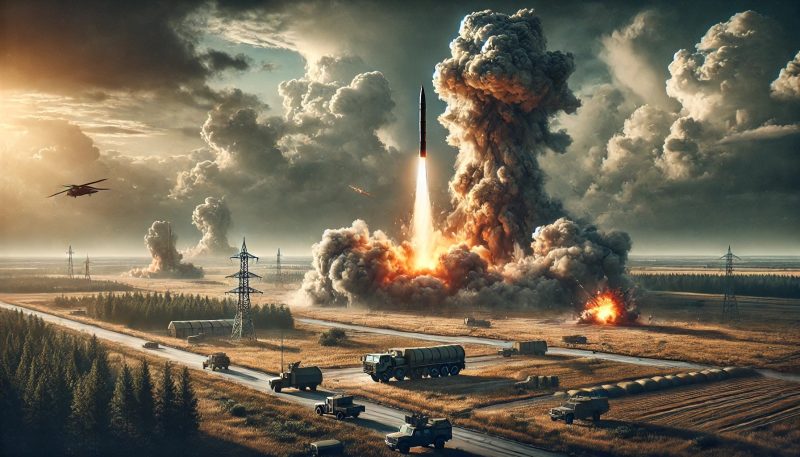
The war in Ukraine took a dramatic turn this week as Ukrainian forces reportedly deployed U.S.-supplied Army Tactical Missile Systems (ATACMS) for the first time against targets deep inside Russian territory.
This escalation marks a bold shift in Ukraine’s military strategy, backed by changing U.S. policy, and signals new challenges for both sides in an already volatile conflict.
What Happened: Ukraine’s Long-Range Missile Strikes
On November 19, Ukrainian forces launched a series of ATACMS missiles targeting a large weapons depot in Russia’s Bryansk region, approximately 115 kilometers from the Ukrainian border. The attack, which struck near Karachev, caused multiple explosions and inflicted significant damage on the facility. Reports from the Russian Ministry of Defense claimed that five out of six missiles were intercepted by air defenses, but debris from the intercepted projectiles led to fires at the site.
These long-range missiles, known for their precision and destructive capability, represent a significant upgrade to Ukraine’s arsenal. They allow Kyiv to strike targets far beyond the front lines, disrupting Russia’s logistics and supply chains in ways previously impossible with shorter-range systems.
A Policy Shift in Washington: Why This Matters
The deployment of ATACMS missiles comes in the wake of a major policy change in Washington. Previously, the Biden administration had imposed restrictions on Ukraine’s use of U.S.-supplied weapons to avoid escalation with Moscow. However, with growing concerns over Russia’s entrenched positions and the need for Ukraine to shift momentum in its favor, these restrictions were quietly lifted.
This decision reflects a deepening U.S. commitment to Ukraine’s defense. The Pentagon has stressed that these missiles are critical for Ukraine’s ability to conduct counteroffensive operations and to strike at the heart of Russian military infrastructure.
By authorizing the use of long-range weapons, the U.S. is not only bolstering Ukraine’s military capacity but also sending a clear message to Moscow: Western support for Ukraine remains unwavering, even as the stakes rise.
Russia’s Reaction: Escalating Nuclear Threats
In response to the missile strikes, Russian President Vladimir Putin signed a decree lowering the threshold for Russia’s use of nuclear weapons. This policy revision explicitly allows for a nuclear response to conventional attacks on Russian soil if those attacks are conducted with the support of a nuclear-armed ally.
While such rhetoric is not new, the formal codification of this doctrine underscores the Kremlin’s alarm over the growing capabilities of Ukraine’s armed forces. Putin’s move has drawn swift condemnation from Western leaders. British officials labeled the threats “depraved,” while EU diplomats called Russia’s nuclear rhetoric “reckless and irresponsible.”
These developments highlight the dangerous balancing act that Western nations face. While supporting Ukraine is seen as a moral and strategic imperative, the risk of miscalculation or unintended escalation remains ever-present.
Implications for the Conflict: What Comes Next?
Ukraine’s use of ATACMS missiles represents more than a tactical victory; it is a signal of how the dynamics of the war are shifting. Here are some key takeaways:
1. Enhanced Ukrainian Capabilities
The ATACMS system gives Ukraine the ability to disrupt Russian operations far beyond the battlefield. This not only complicates Russia’s logistics but also forces Moscow to divert resources to defend areas previously considered safe.
2. Strategic Realignment in the U.S. and NATO
By enabling strikes inside Russia, the U.S. and its NATO allies are signaling a willingness to take calculated risks to counteract Russian aggression. This shift reflects a growing consensus that a more assertive approach is necessary to deter further escalation by Moscow.
3. Rising Risks of Escalation
Russia’s lowered nuclear threshold adds an alarming dimension to the conflict. While analysts believe the actual use of nuclear weapons remains unlikely, the possibility of brinkmanship or miscalculation cannot be ruled out.
4. Increased Pressure on Diplomacy
With both sides doubling down, the prospects for a negotiated settlement appear increasingly remote. However, the international community may face mounting pressure to mediate as the risk of escalation grows.
The Bigger Picture: A New Chapter in the War
This latest development underscores how the war in Ukraine continues to evolve in complexity and intensity. For Kyiv, the deployment of long-range missiles is a critical step toward leveling the playing field against a larger and better-resourced adversary. For Moscow, it is a stark reminder that its control over the narrative and momentum of the war is slipping.
The use of ATACMS missiles may prove to be a turning point, but it also raises urgent questions about the long-term trajectory of the conflict. Will these strikes force Russia to reconsider its military objectives, or will they push the Kremlin toward even more aggressive measures? Can the West sustain its current level of support for Ukraine in the face of mounting risks?
As the conflict enters this dangerous new phase, one thing is clear: the stakes have never been higher—for Ukraine, for Russia, and for the global order.
